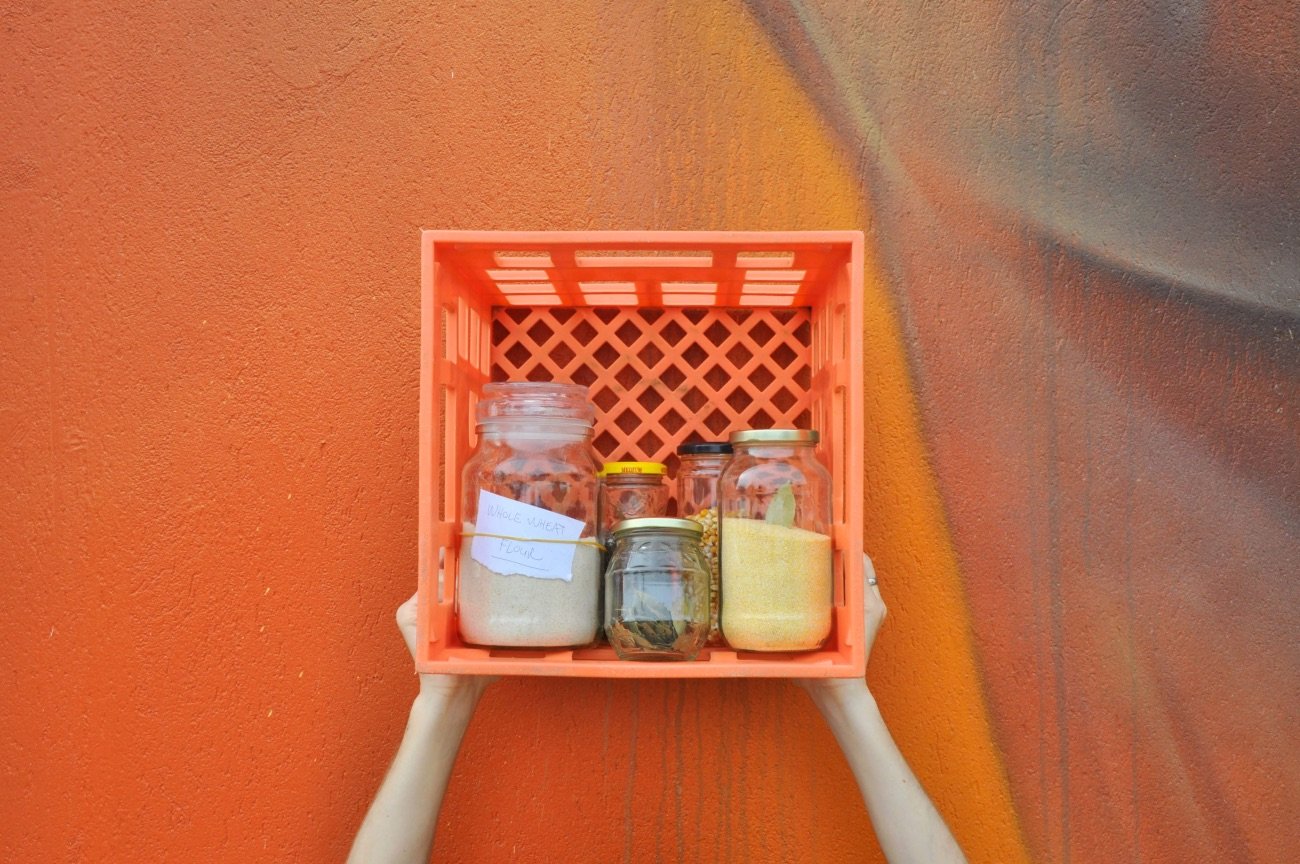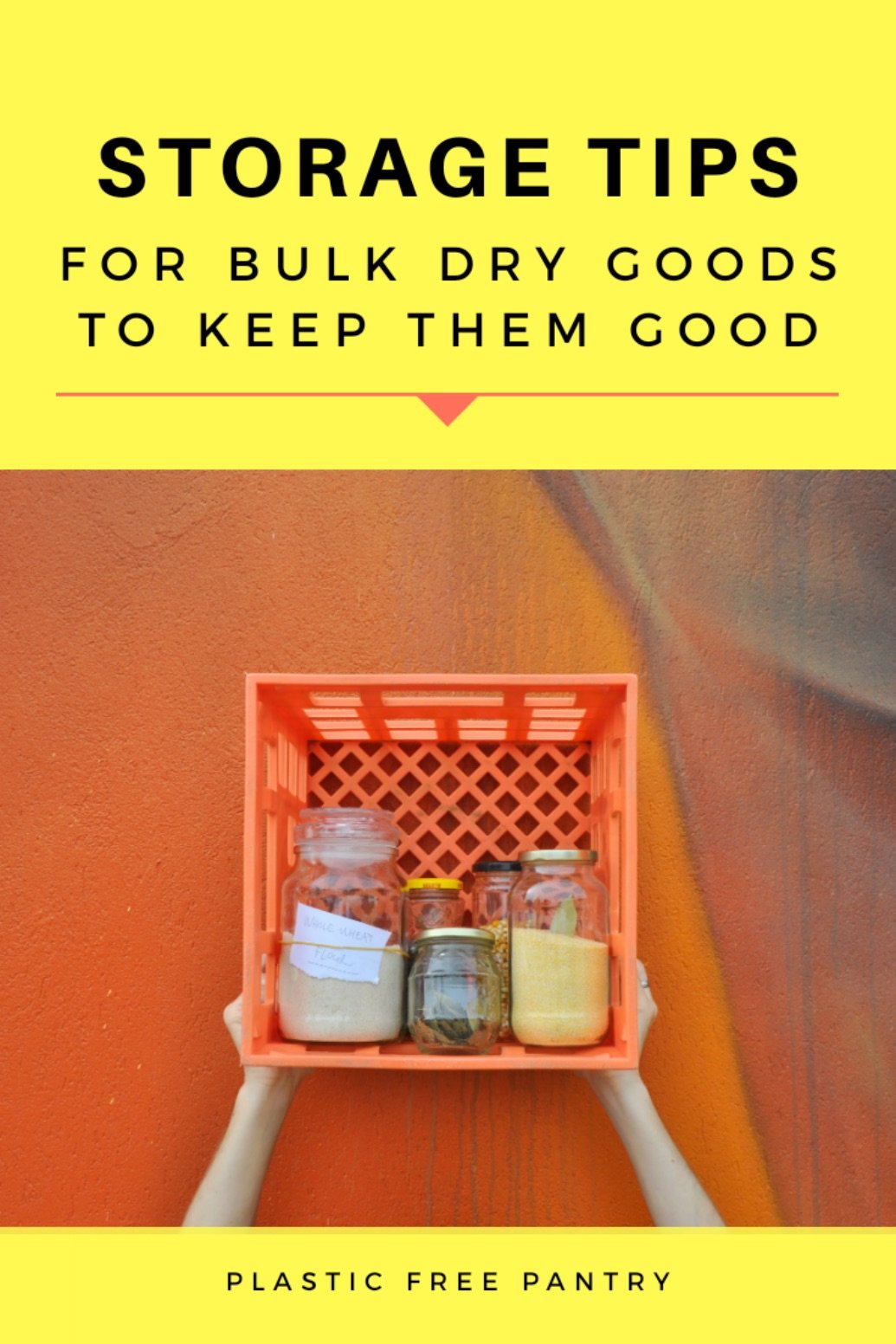Plastic-Free Pantry: Storage Tips For Bulk Dry Goods To Stop Spoiling
When we remove plastic and preservatives from our lives, we need to be more careful about food storage as these are no longer protecting our food from spoiling. How do you store bulk-bought dry goods and other packaging-free pantry items so that they don’t spoil and your pantry doesn’t become moth ridden?
JUMP TO:
We need to be more careful about food storage when we remove plastic and preservatives from our lives, as these are no longer protecting our food from spoiling.
I was rudely reminded of this one morning when I opened a glass jar I had refilled with syrup at the local bulk food store, only to find mould growing on the drops of syrup on the inside of the lid. There would be no syrup on my oats that day.
It was then that I remembered that the large container of syrup I had refilled my jar with had been in a fridge. Light bulb! I should have stored it in the fridge but I had put it away in my pantry after coming home from shopping because that's where I've put syrup most of my life.
I've also had a few pantry moths flying out of my chia seeds when opening them up.
Luckily there are easy fixes to these problems! We share all the bulk food storage tips we could find below, as well as looking into some serious food safety concerns.
What’s the scoop on bugs in food sold in bulk?
Should we be worried about bugs in food sold in bulk?
Most dried food products can be infested by insects, for example flour, rice, pasta, seeds, dried beans, popcorn, nuts, raisins and other dried fruits, spices, and tea, and these pantry pests “are most likely to infest products that have been opened but they also can get into unopened paper, thin cardboard, and plastic, foil or cellophane-wrapped packages” (Source).
A food product can become infested at any point from when it is produced to when you get it home from the grocery store and all food is allowed to be sold with a certain percentage of ‘impurities’ - this includes insects. But stored food is most likely to become infested in the grocery store or in homes, with food products that are left in storage for a long time being prone to infestation.
Thus, food sold in bulk at bulk food stores is more likely to possibly become infested as it is more in the open than packaged food and it will be more likely to become infested if the bulk food store does not have a high turnover of product. And gravity-fed bins are less likely to become contaminated as they are more enclosed and can’t be left open by mistake, they are often smaller so will be filled more often and they are filled in a way that the older product is all used up before the new product on top of it (and people can’t sticking their hands in the food so less germs).
If you are worried about infestation, consider the overall cleanliness of the bulk food store, how busy it is, how often they refill their food bins, whether they use gravity-fed bins, if the containers the food is in are sealed tight, keeping air and bugs out, and if there are crumbs or dust at the bottom of the food bins (if so they are probably not properly emptied and cleaned out).
Feel free to ask how often the dispensers are cleaned out and refilled and if you find food you have bought from a store is infested, politely let them know so they can improve their food safety standards.
Personally, we have only had one incidence of infested food in the three years (moth eggs in chai seeds) we have been buying food in bulk and the United States Food and Drug Administration and the commissioner of the Connecticut State Department of Consumer Protection have both never received any complaints or reports of illness linked to bulk sales, according to this article.
So, as long as the store follows basic food safety and hygiene practices, this shouldn’t be an issue, but it can be. We share how to prevent pantry moths in case you do end up bringing any home and to make sure you aren’t the cause of an infestation of your own food, as well as what to do if pantry pests do find their way into your dry goods and pantry, below.
Preventing pantry moths and other pantry pests
If you are worried about bringing bugs home from the bulk food store or making sure pantry pests don’t get into your food in your kitchen at home, there are a few easy ways to prevent pantry moths and other pantry pests:
don’t buy huge amounts of dried goods, but rather buy dried foods in quantities that are small enough to be used up in a short period of time (about two to four months),
make sure your bulk dry goods are stored in airtight containers,
don’t let dry goods sit in your pantry unused for too long - label it with the date you got it and use up old food before buying more and refilling,
freeze grains and seeds before placing them in the pantry or store them in the refrigerator or freezer (more on this below!), and
keep your kitchen, pantry, and other food storage areas clean (not forgetting the back of and corners of kitchen cupboards!) and free of crumbs and spilled food.
Other ways of deterring pantry moths that are often used and recommended include the following, although these methods are not scientifically proven, they are not discredited either, so they could work:
string a few dried bay leaves up in your pantry, put them in drawers and cupboards in little cloth bags or put them in your jars of dry goods,
keep cedar wood chips in open glass jars mixed about your pantry shelves, and
wipe down pantry surfaces thoroughly with peppermint oil.
Freezing flour, grains, and seeds when you first get them home from a bulk food store will kills off any moth larvae or insect eggs that might be present so you don’t bring them into your home unknowingly. Most people recommend leaving it in the freezer for at least 24 hours, but the University of Minnesota says they need to be in a freezer for at least four days for eggs or insects to be killed.
In addition, according to the University of Minnesota, “washing areas with detergents, ammonia, or bleach will not prevent insect infestation” and “there is no evidence that placing bay leaves or sticks of spearmint gum in a cupboard will prevent or get rid of stored food insect pests”.
Food that should be stored in the fridge
With unpackaged bulk goods, certain things that you are used to storing in the pantry, actually should be stored in the fridge. This will make them last longer, prevent pantry pests from getting into them, and stop them from going mouldy in some instances.
Foods that should actually be stored in the fridge include (source):
nuts and seeds - this will make them last longer as it prevents the oils in nuts and seeds from turning rancid,
nut butters - homemade and preservative free nut butters last longer in the fridge,
bread - cool, dark places like a bread bin or the fridge keeps bread fresher for longer,
flours - especially if the humidity is high as this speeds up the process of oils released in flours deteriorating the flour over time,
any food products that you buy that are stored in the fridge at the store like the maple syrup we bought in bulk (apparently maple syrup should always be stored in the fridge as it is susceptible to mould) - if it is stored in a fridge or freezer where you bought it from, it should probably be stored in the fridge or freezer at home.
Finally, if a food product is attracting moths or bugs in your pantry, try storing in the fridge instead.
My food’s infected! What now? Do I have to throw it all out?
What should you do if your food is infected? You could sift things like flour before using it to remove any bugs that might be in there and we were told we could save our mouldy syrup by scooping the mould off the top and slowly reboiling the syrup, but we are not 100% sure of the safety of this.
Freezing food products for at least four days or baking it on a shallow cookie sheet or pan in an oven at 130 degrees for at least 30 minutes will kill any eggs or insects. It is up to you whether you still eat the food after killing and sifting out the eggs or insects.
Ingesting pantry moths or their larvae, eggs, or webbing shouldn’t make you sick. Indian meal moths, which are the most common moth to infest foods, are not known to spread any known diseases, parasites or pathogens.
However, the University of Minnesota recommends throwing out any infested food. This is heartbreaking for people like us who are trying to avoid waste at all costs, but health comes first so it might have to be done to er on the side of caution and it could save other food from being lost due to it becoming infected too.
If you are wondering what I would personally do, I would still eat it after killing and sifting the eggs or insects, but this is a personal decision and it might not be the right decision for you. It is probably better to take a university’s advice.
After getting rid of the infested food, the university then says to:
use a vacuum cleaner to thoroughly clean cabinets and shelves, especially in cracks and corners, to pick up crawling insects and spilled or infested material and to empty the vacuum cleaner or discard the vacuum cleaner bag after use to prevent re-infestation,
treating other foods you think might be affected by freezing or baking it, and
store foods in sealable glass, metal, or heavy plastic containers or in the freezer or refrigerator until you are sure the infestation is gone to prevent re-infestation.
It stresses that “washing shelves with detergent, bleach, ammonia, or disinfectants will not keep pantry pests from returning and could be dangerous if the chemicals come in contact with food”.
Home canning & infused oils: What is botulism and should I be worried about it?
When it comes to storage of food at home, one disease you do need to worry about is botulism. This can be caused by improper canning of vegetables and fruits and infusing oils at home.
The Centers for Disease Control and Prevention (CDC) explains that “botulism is a rare but potentially deadly illness caused by a poison most commonly produced by a germ called Clostridium botulinum, which is found in soil and can survive, grow, and produce a toxin in certain conditions, such as when food is improperly canned”.
It is important to use proper canning techniques and the right equipment for the kind of foods that you are canning, for instance high temperature pressure canning is the only recommended method for canning low-acid foods, which includes most vegetables, meats and seafood.
C. botulinum needs a near-oxygen-free environment to grow and it doesn’t like acid. Placing a low-acid or non-acidic food in a low-oxygen environment such as a home-canning jar provides the perfect environment for it to grow. In addition, covering a low-acid food in oil eliminates oxygen availability and provides an environment C. botulinum love, for example putting a sprig of rosemary in a bottle of olive oil can allow C. botulinum to grow in the bottle (source).
Therefore, air and acids such as vinegar, lemon and lime juice help to keep us safe from food-borne botulism; hence, why people preserve foods by pickling them in vinegar. Fermenting foods creates an environment that is antagonistic to botulism as good bacteria acidifies the food and salt reduces its ability to grow, so vegetable fermentation is not risky (source).
If a container is leaking, bulging, or swollen, looks damaged, cracked, or abnormal, or spurts liquid or foam when opened, or the food is discoloured, mouldy, or smells bad, home-canned (and store-bought) food might be contaminated with this toxin or other harmful germs and is not safe to eat, according to the CDC.
The FDA lists the following foods as having a high risk of causing botulism:
home-canned foods with a low acid content,
improperly canned commercial foods,
home-canned or fermented fish,
herb-infused oils,
baked potatoes in aluminium foil kept at room temperature,
cheese sauce,
bottled garlic, and
foods held warm for extended periods of time.
According to the University of Maine, which does not advise home cooks to try to acidify foods, “the safest way for home cooks to prepare flavoured or infused oils is to use properly dried herbs, garlic, or vegetables” as C. bot bacteria will not grow on these since dried ingredients contain no water.
When preparing flavoured and infused oils at home, to do so safely, it recommends:
washing, sanitising (put in boiling water for 30 seconds), and thoroughly air drying the container and lid you will be using,
using dried garlic and/or herbs, and
heating the oil you will be using to 85°C (180°F) in a pot before pour it over the dried additives and capping the container.
These oils must then be stored in a cool, dark place to prevent the fat from going rancid and they must not be stored for more than three months, according to the university.
Hopefully these tips help you keep your dry goods clear of insects and your canned fruit and veg and infused oils safe to eat!
Did any of these storage tips surprise you? Have you been storing your food incorrectly? We learnt loads writing this article! Let us know what you learnt in the comments.
*we maintain this site in our free time and support in any way, shape or form means a lot and helps us keep it running, whether it is using an affiliate link when investing in something, sharing our content, or buying us a coffee on Ko-fi.



